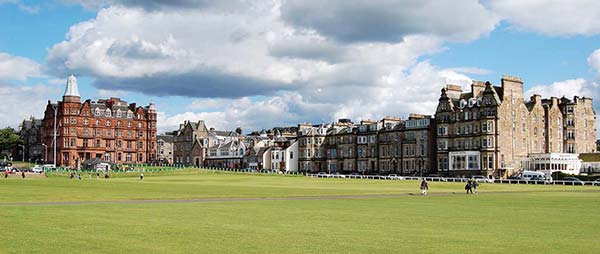
St. Andrews • Dundee • Glamis Castle • The East Neuk
St. Andrews is synonymous with golf. But there’s much more to this charming town than its famous links. Dramatically situated at the edge of a sandy bay, St. Andrews is the home of Scotland’s most important university—think of it as the Scottish Cambridge. And centuries ago, the town was the religious capital of the country.
In its long history, St. Andrews has seen two boom periods. First, in the early Middle Ages, the relics of St. Andrew made the town cathedral one of the most important pilgrimage sites in Christendom. The faithful flocked here from all over Europe, leaving the town with a medieval all-roads-lead-to-the-cathedral street plan that survives today. But after the Scottish Reformation, the cathedral rotted away and the town became a forgotten backwater. A new wave of visitors arrived in the mid-19th century, when a visionary mayor (with the on-the-nose surname Playfair) began to promote the town’s connection with the newly in-vogue game of golf. Most buildings in town date from this Victorian era.
Today St. Andrews remains a popular spot for students, golf devotees (from amateurs to professional golfers to celebrities), and occasionally Britain’s favorite royal couple, Will and Kate (college sweethearts, U. of St. A. class of ’05). With vast sandy beaches, golfing opportunities for pros and novices alike, playgrounds of castle and cathedral ruins, and a fun-loving student vibe, St. Andrews is an appealing place to take a vacation from your busy vacation. It’s also a handy home base for a variety of worthwhile side-trips: interesting museums in the big city of Dundee, the castle home of the late Queen Mother, and a string of relaxing fishing villages (the East Neuk).
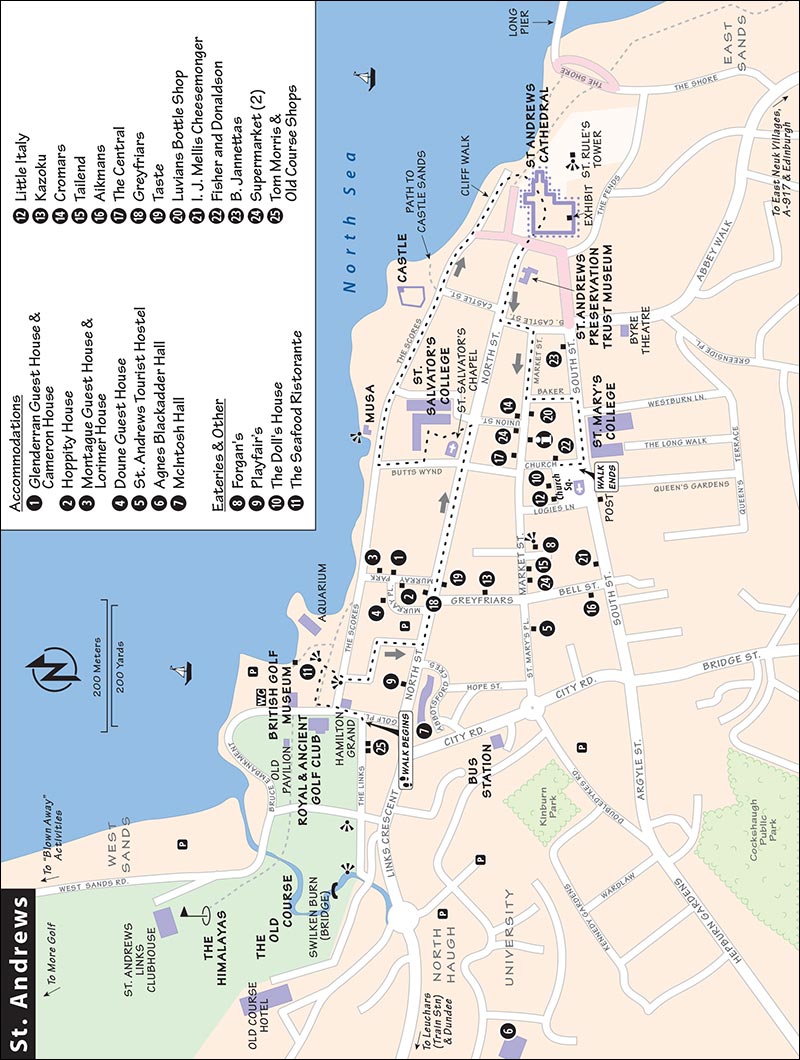
St. Andrews, hugging the east coast of Scotland, is a bit off the main tourist track. But it’s well connected by train to Edinburgh (via bus from nearby Leuchars), making it a worthwhile day trip from the capital. Better yet, spend a night (or more, if you’re a golfer) to enjoy this university town after dark.
If you’re not here to golf, this is a good way to spend a day: Follow my self-guided walk, which connects the golf course, the university quad, the castle, and the cathedral. Dip into the Golf Museum, watch the golfers on the Old Course, and play a round at “the Himalayas” putting green. With more time, walk along the West Sands beach, take a spin by car or bus to the nearby East Neuk, or drive up to the museums in Dundee. Dundee and Glamis Castle are also fine stops for those connecting St. Andrews to points north.
St. Andrews (pop. 16,000, plus several-thousand more students during term) is situated at the tip of a peninsula next to a broad bay. The town retains its old medieval street plan: Three main streets (North, Market, and South) converge at the cathedral, which overlooks the sea at the tip of town. The middle street—Market Street—has the TI and many handy shops and eateries. North of North Street, the seafront street called The Scores connects the cathedral with the golf scene, which huddles along the West Sands beach at the base of the old town. St. Andrews is compact: You can stroll across town—from the cathedral to the historic golf course—in about 15 minutes.
St. Andrews’ helpful TI is on Market Street, about two blocks in front of the cathedral (Mon-Sat 9:15-17:00, Sun from 10:00, closed Sun in winter; free Wi-Fi, 70 Market Street, tel. 01334/472-021, www.visitscotland.com).
By Train and Bus: The nearest train station is in the village of Leuchars, five miles away. From there, a 10-minute bus ride takes you right into St. Andrews (buy ticket from driver, buses meet most trains—see schedule at bus shelter for next bus to St. Andrews; while waiting, read the historical info under the nearby flagpole). St. Andrews’ bus station is near the base of Market Street—a short walk from most B&Bs and the TI. A taxi from Leuchars into St. Andrews costs about £14.
By Car: For a short stay, drivers can park anywhere along the street in the town center (pay-and-display, coins only, 2-hour limit, monitored Mon-Sat 9:00-17:00, Sun from 13:00). For longer stays, you can park for free along certain streets near the center (such as the small lot near the B&B neighborhood around Murray Place, and along The Scores), or use one of the pay-and-display lots near the entrance to town.
Golf Events: Every five years, St. Andrews is swamped with about 100,000 visitors when it hosts the British Open (officially called “The Open Championship”; the next one will be the 150th in 2021). The town also fills up every year in early October for the Alfred Dunhill Links Championship. Unless you’re a golf pilgrim, avoid the town at these times (as room rates skyrocket).
School Term: The University of St. Andrews has two terms: spring semester (“Candlemas”), from mid-February through May; and fall semester (“Martinmas”), from mid-September until December. St. Andrews has a totally different vibe in the summer, when most students leave and are replaced by upper-crust golfers and tourists.
Sand Surfing and Adventure Activities: Nongolfers who want to stay busy while their travel partners play the Old Course may enjoy some of the adventure activities offered by Blown Away—including “land yachting” (zipping across the beach in wind-powered go-carts), kayaking, and paddle boarding. Brothers Guy and Jamie McKenzie set up shop at the northern tip of the West Sands beach (sporadic hours—call first, mobile 07784-121-125, www.blownaway.co.uk, ahoy@blownaway.co.uk).
Theater: The Byre Theatre regularly hosts concerts, shows, dance, and opera. Check their website or stop in to see what’s on (tickets about £10-25, Abbey Street, tel. 01334/475-000, www.byretheatre.com).
Ghost Tours: Richard Falconer, who has researched and written books on paranormal activity in the area, gives 1.5-hour tours mixing St. Andrews history with ghost stories (£12, tours at 16:00, 17:30, 19:30, and 21:00, must book ahead, text 0746-296-3163 or visit www.standrewsghosttours.com).
(See “St. Andrews” map, here.)
This walk links all of St. Andrews’ must-see sights and takes you down hidden medieval streets. Allow a couple of hours, or more if you detour for the sights along the way.
• Start at the base of the seaside street called The Scores, overlooking the famous golf course.
You’re looking at the mecca of golf. The 18th hole of the world’s first golf course is a few yards away, on your left (for info on playing the course, see “Golfing in St. Andrews,” later).
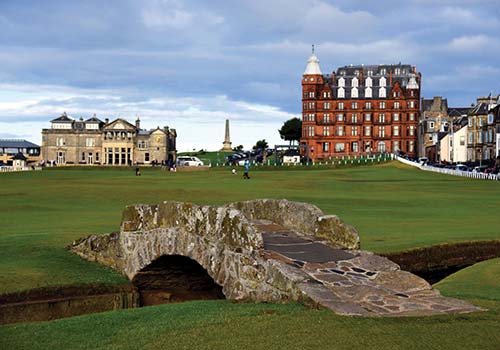
The gray Neoclassical building to the right of the 18th hole is the clubhouse of the Royal and Ancient Golf Club—“R&A” for short. R&A is a private club with membership by invitation only; it was men-only until 2014, but now—finally!—women are also allowed to join. (In Scotland, men-only clubs lose tax benefits, which is quite costly, but they generally don’t care about expenses because their membership is wealthy.) The shop (across the street from the 18th hole, next to Tom Morris—the oldest golf shop in the world) is a great spot to buy a souvenir for the golf lover back home. Even if you’re not golfing, watch the action for a while. (Serious fans can walk around to the low-profile stone bridge across the creek called the Swilken Burn, with golf’s single most iconic view: back over the 18th hole and the R&A Clubhouse.)
Overlooking the course is the big red-sandstone Hamilton Grand, an old hotel that was turned into university dorms and then swanky apartments (rumor has it Samuel L. Jackson owns one). According to town legend, the Hamilton Grand was originally built to upstage the R&A Clubhouse by an American upset over being declined membership to the exclusive club.
Between Hamilton Grand and the beach is the low-profile British Golf Museum (described on here).
• Now turn your back to the golf course and walk through the park toward the obelisk (along the street called The Scores). Stop at the top of the bluff.
The broad, two-mile-long sandy beach that stretches below the golf course is the West Sands. It’s a wonderful place for a relaxing and/or invigorating walk. Or do a slo-mo jog, humming the theme to Chariots of Fire—this is the beach on which the characters run in the movie’s famous opening scene.
From the bluff, look at the cliffs on your right. The sea below was once called “Witches’ Lake” because of all the women and men pushed off the cliff on suspicion of witchcraft.
The big obelisk is a martyrs’ monument, commemorating all those who died for their Protestant beliefs during the Scottish Reformation. (We’ll learn more about that chapter of St. Andrews history farther along this walk.)
The Victorian bandstand gazebo (between here and the Old Course) recalls the town’s genteel heyday as a seaside resort, when the train line ran all the way to town.
• Just opposite the obelisk, across The Scores and next to Alexander’s Restaurant, walk down the tiny alley called...
This winds through the back gardens of the city’s stone houses. Notice how the medieval platting gave each landowner a little bit of street front and a long back garden. St. Andrews’ street plan typifies that of a medieval pilgrimage town: All main roads lead to the cathedral; only tiny lanes, hidden alleys, and twisting “wynds” (rhymes with “minds”) such as this one connect the main east-west streets.
• The wynd pops you out onto North Street. Head left, past the cinema toward the church tower with the red clock face. It’s on the corner of North Street and Butts Wynd. For some reason, this street sign often goes missing.
The tower with the red clock marks the entrance to St. Salvator’s College. If you’re a student, be careful not to stand on the initials PH in the reddish cobbles in front of the gate. These mark the spot where St. Andrews alum and professor Patrick Hamilton—the Scottish Reformation’s most famous martyr—was burned at the stake. According to student legend, as he suffered in the flames, Hamilton threatened that any students who stood on this spot would fail their exams.
Now enter the grounds by walking through the arch under the tower. (If the entrance is closed, you can go halfway down Butts Wynd and enter, or at least look, through the gate to the green square.) This grassy square, known to students as Sally’s Quad, is the heart of the university. As most of the university’s classrooms, offices, and libraries are spread out across the medieval town, this quad is the one focal point for student gatherings. It’s where graduation is held every July, where the free-for-all food fight of Raisin Monday takes place in November (see sidebar on here), and where almost the entire student body gathered on the wedding day of their famous alumni couple Prince William and Kate Middleton for a celebration complete with military flybys.
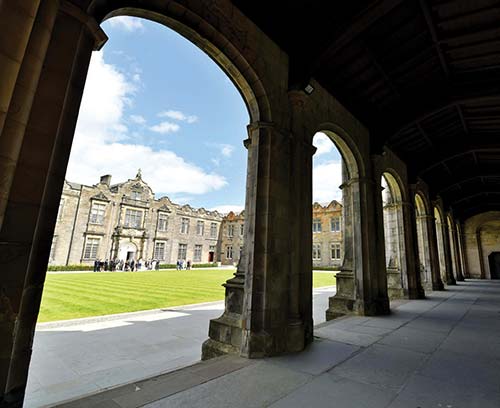
On the outside wall of St. Salvator’s Chapel, under the arcade, are display cases holding notices and university information; if you’re here in spring, you might see students nervously clustered here, looking to see if they’ve passed their exams.
Go through the simple wooden door and into the chapel. Dating from 1450, this is the town’s most beautiful medieval church. It’s a Gothic gem, with a wooden ceiling, 19th-century stained glass, a glorious organ, and what’s supposedly the pulpit of reformer John Knox.
Stroll around Sally’s Quad counterclockwise. On the east (far) side, stop to check out the crazy faces on the heads above the second-floor windows. Find the university’s shield over the door marked School 6. The diamonds are from the coat of arms of the bishop who issued the first university charter in 1411; the crescent moon is a shout-out to Pope Benedict XIII, who gave the OK in 1413 to found the university (his given name was Peter de Luna); the lion is from the Scottish coat of arms; and the X-shaped cross is a stylized version of the Scottish flag (a.k.a. St. Andrew’s Cross). On the next building to the left, facing the chapel, is St. Andrew himself (above door of building labeled Lower & Upper College Halls).
• Exit the square and make your way back to Butts Wynd. Walk to the end; you’re back at The Scores. Across the street and a few steps to the right is the...
This free museum is worth a quick stop. The first room has some well-explained medieval artifacts. Find the copy of the earliest-known map of the town, made in 1580—back when the town walls led directly to the countryside and the cathedral was intact. Notice that the street plan within the town walls has remained the same—but no golf course. The next room has some exhibits on student life, including the “silver arrow competition” (which determined the best archer on campus from year to year) and several of the traditions explained in the “Student Life in St. Andrews” sidebar. The next room displays scientific equipment, great books tied to the school, and an exhibit on the Scottish Reformation. The final room has special exhibits. For a great view of the West Sands, climb to the rooftop terrace.
Cost and Hours: Free; Mon-Sat 10:00-17:00, Sun 12:00-16:00, shorter hours and closed Mon-Wed in winter; 7 The Scores, tel. 01334/461-660, www.st-andrews.ac.uk/musa.
• Leaving the museum, walk left toward the castle. The turreted stone buildings along here (including one fine example next door to the museum) are built in the Neo-Gothic Scottish Baronial style, and most are academic departments. About 100 yards farther along, the grand building on the right is St. Salvator’s Hall, the most prestigious of the university residences and former dorm of Prince William.
Just past St. Salvator’s Hall on the left are the remains of...
Overlooking the sea, the castle is an evocative empty shell—another casualty of the Scottish Reformation. With a small museum and good descriptions, it offers a quick king-of-the-castle experience in a striking setting.
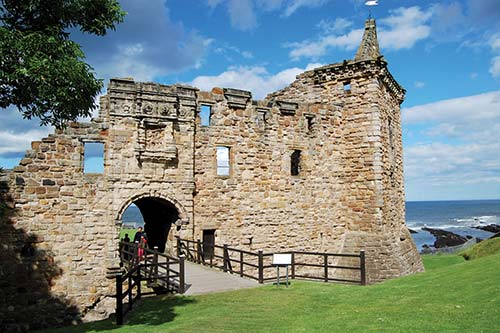
Cost and Hours: £6, £9 combo-ticket includes cathedral exhibit, daily April-Sept 9:30-17:30, Oct-March 10:00-16:00, tel. 01334/477-196, www.historic-scotland.gov.uk.
Visiting the Castle: Your visit starts with a colorful, kid-friendly exhibit about the history of the castle. Built by a bishop to entertain visiting diplomats in the late 12th century, the castle was home to the powerful bishops, archbishops, and cardinals of St. Andrews. In 1546, the cardinal burned a Protestant preacher at the stake in front of the castle. In retribution, Protestant reformers took the castle and killed the cardinal. In 1547, the French came to attack the castle on behalf of their Catholic ally, Mary, Queen of Scots. During the ensuing siege, a young Protestant refugee named John Knox was captured and sent to France to row on a galley ship. Eventually he traveled to Switzerland and met the Swiss Protestant ringleader, John Calvin. Knox brought Calvin’s ideas back home and became Scotland’s greatest reformer.
Next, head outside to explore. The most interesting parts are underground: the “bottle dungeon,” where prisoners were sent, never to return (peer down into it in the Sea Tower); and the tight “mine” and even tighter “counter-mine” tunnels (follow the signs; crawling is required to reach it all—go in as far as your claustrophobia allows). This shows how the besieging pro-Catholic Scottish government of the day dug a mine to take (or “undermine”) the castle—but were followed at every turn by the Protestant counter-miners.
Nearby: Just below the castle is a small beach called the Castle Sands, where university students take a traditional and chilly morning dip on May 1. Supposedly, doing this May Day swim is the only way to reverse the curse of having stepped on Patrick Hamilton’s initials (explained earlier).
• Leaving the castle, turn left and continue along the bluff on The Scores, which soon becomes a pedestrian lane leading directly to the gate to the cathedral graveyard. Enter it to stand amid the tombstone-strewn ruins of...
Between the Great Schism and the Reformation (roughly the 14th-16th centuries), St. Andrews was the ecclesiastical capital of Scotland—and this was its showpiece church. Today the site features the remains of the cathedral and cloister (with walls and spires pecked away by centuries of scavengers), a graveyard, and a small exhibit and climbable tower.
Cost and Hours: Cathedral ruins-free, exhibit and tower-£5, £9 combo-ticket includes castle; daily April-Sept 9:30-17:30, Oct-March 10:00-16:00, tel. 01334/472-563, www.historic-scotland.gov.uk.
Background: It was the relics of the Apostle Andrew that first put this town on the map and gave it its name. There are numerous legends associated with the relics. According to one version, in the fourth century, St. Rule was directed in a dream to bring the relics northward from Constantinople. When the ship wrecked offshore from here, it was clear that this was a sacred place. Andrew’s bones (an upper arm, a kneecap, some fingers, and a tooth) were kept on this site, and starting in 1160, the cathedral was built and pilgrims began to arrive. Since St. Andrew had a direct connection to Jesus, his relics were believed to possess special properties, making them worthy of pilgrimages on par with St. James’ relics in Santiago de Compostela, Spain (of Camino de Santiago fame). St. Andrew became Scotland’s patron saint; in fact, the white “X” on the blue Scottish flag evokes the diagonal cross on which St. Andrew was crucified (he chose this type of cross because he felt unworthy to die as Jesus had).
Visiting the Cathedral: You can stroll around the cathedral ruins—the best part of the complex—for free. First, walk between the two ruined but still-towering ends of the church, which used to be the apse (at the sea end, where you entered) and the main entry (at the town end). Visually trace the gigantic footprint of the former church in the ground, including the bases of columns—like giant sawed-off tree trunks. Plaques identify where elements of the church once stood.
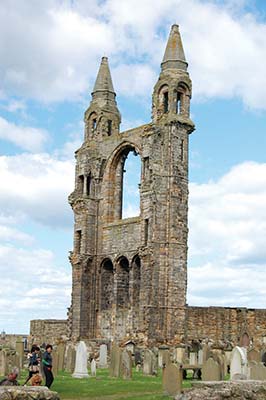
Looking at the one wall that’s still standing, you can see the architectural changes that were made over the 150 years the cathedral was built—from the rounded, Romanesque windows at the front to the more highly decorated, pointed Gothic arches near the back. Try to imagine this church in its former majesty, when it played host to pilgrims from all over Europe.
The church wasn’t destroyed all at once, like all those ruined abbeys in England (demolished in a huff by Henry VIII when he broke with the pope). Instead, because the Scottish Reformation was more gradual, this church was slowly picked apart over time. First just the decorations were removed from inside the cathedral. Then the roof was pulled down to make use of its lead. Without a roof, the cathedral fell further and further into disrepair, and was quarried by locals for its handy precut stones (which you’ll still find in the walls of many old St. Andrews homes). The elements—a big storm in the 1270s and a fire in 1378—also contributed to the cathedral’s demise.
The surrounding graveyard, dating from the post-Reformation Protestant era, is much more recent than the cathedral. In this golf-obsessed town, the game even infiltrates the cemeteries: Many notable golfers from St. Andrews are buried here, including four-time British Open winner Young Tom “Tommy” Morris.
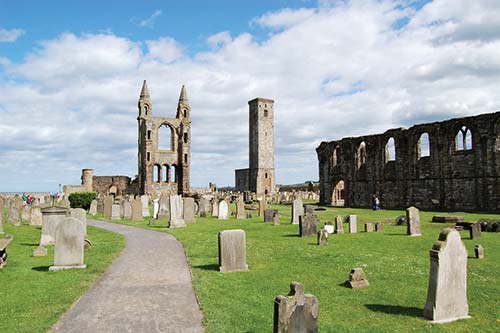
Go through the surviving wall into the former cloister, marked by a gigantic grassy square in the center. You can still see the cleats up on the wall, which once supported beams. Imagine the cloister back in its heyday, its passages filled with strolling monks.
At the end of the cloister is a small exhibit (entry fee required), with a relatively dull collection of old tombs and other carved-stone relics that have been unearthed on this site. Your ticket also includes entry to the surviving tower of St. Rule’s Church (the rectangular tower beyond the cathedral ruins that was built to hold the precious relics of St. Andrew about a thousand years ago). If you feel like hiking up the 157 very claustrophobic steps for the view over St. Andrews’ rooftops, it’s worth the price. Up top, you can also look out to sea to find the pier where students traditionally parade in their robes (see sidebar on here).
• Leave the cathedral grounds on the town side of the cathedral. Angling right, head down North Street. Just ahead, on the left, is the adorable...
Filling a 17th-century fishing family’s house that was protected from developers, this museum is a time capsule of an earlier, simpler era. The house itself seems built for Smurfs, but it once housed 20 family members. The ground floor features replicas of a grocer’s shop and a “chemist’s” (pharmacy), using original fittings from actual stores. Upstairs are temporary exhibits. Out back is a tranquil garden (dedicated to the memory of a beloved professor) with “great-grandma’s washhouse,” featuring an exhibit about the history of soap and washing. Lovingly presented, this quaint, humble house provides a nice contrast to the big-money scene around the golf course at the other end of town.
Cost and Hours: Free but donation requested, generally open June-Sept daily 14:00-17:00, closed off-season, 12 North Street, tel. 01334/477-629, www.standrewspreservationtrust.org.
• From the museum, hang a left around the next corner to South Castle Street. Soon you’ll reach...
At the top of Market Street—one of the most atmospheric old streets in town—look for the tiny white house on your left, with the cute curved staircase. What’s that chase scene on the roof?
Now turn right down Market Street (which leads directly to the town’s center, but we’ll take a curvier route). Notice how the streets and even the buildings are smaller at this oldest end of town, as if the whole city is shrinking as the streets close in on the cathedral. Homeowners along Market Street are particularly proud of their address, and recently pooled their money to spiff up the cobbles and sidewalks.
Passing an antique bookstore on your right, take a left onto Baker Lane, a.k.a. Baxter Wynd. You’ll pass a tiny and inviting public garden on your right before landing on South Street.
• Turn right and head down South Street. After 50 yards, cross the street and enter a gate marked by a cute gray facade and a university insignia.
This is the home of the university’s School of Divinity (theology). If the gate’s open, find the peaceful quad, with its gnarled tree that was purportedly planted by Mary, Queen of Scots. To get a feel of student life from centuries past, try poking your nose into one of the old classrooms.
• Back on South Street, continue to your left. Some of the plainest buildings on this stretch of the street have the most interesting history—several of them were built to fund the Crusades. Turn right on Church Street. You can end this walk at charming Church Square—perhaps while enjoying a decadent pastry from the recommended Fisher and Donaldson bakery. Or if you continue a few more yards down Church Street, you’ll spill onto Market Street and the heart of town.
St. Andrews is the Cooperstown of golf. While St. Andrews lays claim to founding the sport (the first record of golf being played here was in 1553), nobody knows exactly where and when people first hit a ball with a stick for fun. In the Middle Ages, St. Andrews traded with the Dutch; some historians believe they picked up a golf-like Dutch game played on ice and translated it to the bonnie rolling hills of Scotland’s east coast. Since the grassy beachfront strip just outside St. Andrews was too poor to support crops, it was used for playing the game—and, centuries later, it still is. Why do golf courses have 18 holes? Because that’s how many fit at the Old Course—golf’s single most famous site. When you putt-er around, keep in mind this favorite Scottish say-it-aloud joke: “Balls,” said the queen. “If I had two, I’d be king.” The king laughed—he had to.
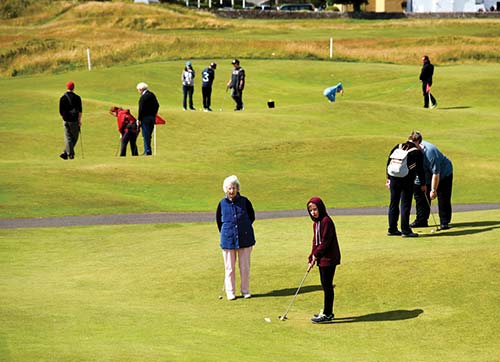
The Old Course hosts the British Open every five years (next in 2021). At other times it’s open to the public for golfing. The famous Royal and Ancient Golf Club (R&A) doesn’t actually own the course, which is public and managed by the St. Andrews Links Trust. Drop by the St. Andrews Links Clubhouse, overlooking the beach near the Old Course (open long hours daily). They have a well-stocked shop, a restaurant, and a rooftop garden with nice views over the Old Course.
Old Course Tours: One-hour guided tours visit the 1st, 17th, and 18th holes (£10, daily April-May at 11:00, June-Sept at 11:00 and 14:00, leaves from the St. Andrews Links Clubhouse, tel. 01334/466-666, www.standrews.com).
Teeing Off at the Old Course: Playing at golf’s pinnacle course is pricey (£175/person, less off-season), but open to the public—subject to lottery drawings for tee times and reserved spots by club members. You can play the Old Course only if you have a handicap of 24 (men) or 36 (women and juniors) or better; bring along your certificate or card. If you don’t know your handicap—or don’t know what “handicap” means—then you’re not good enough to play here (they want to keep the game moving). If you play, you’ll do nine holes out, then nine more back in—however, all but four share the same greens.
Reserving a Tee Time: To ensure a specific tee time at the Old Course, reserve a year ahead during a brief window between late August and early September (fill out form at www.standrews.com). Otherwise, some tee times are determined each day by a lottery called the “daily ballot.” Enter your name on their website, in person, or by calling 01334/466-666—by 14:00 two days before (2 players minimum, 4 players max). They post the results online at 16:00. Note that no advance reservations are taken on Saturdays or in September, and the courses are closed on Sundays—which is traditionally the day reserved for townspeople to stroll.
Singleton Strategies: Single golfers aren’t eligible to reserve or ballot. If you’re golfing solo, you could try to team up with someone (ask your B&B for tips). Otherwise, each day, a few single golfers fill out a two- or three-golfer group by showing up in person at the Old Pavilion (in front of the R&A Clubhouse). It’s first-come, first-served, and a very long shot, so get there early. The starter generally arrives at 6:00, but die-hard golfers start lining up several hours before or even camp out overnight (especially in peak season). Swing by the day before, when they should have a sense of how likely a spot is to open up and can recommend just how early to arrive.
Other Courses: Two of the seven St. Andrews Links courses are right next to the Old Course—the New Course and the Jubilee Course. And the modern cliff-top Castle Course is just outside the city. These are cheaper, and it’s much easier to get a tee time (£75 for New and Jubilee, £120 for Castle Course, much less for others). It’s usually possible to get a tee time for the same day or next day (if you want a guaranteed reservation, make it at least 2 weeks in advance). The Castle Course has great views overlooking the town, but even more wind to blow your ball around.
Club Rental: You can rent decent-quality clubs around town for about £30. The Auchterlonies shop has a good reputation (on Golf Place—a few doors down from the R&A Clubhouse, tel. 01334/473-253, www.auchterlonies.com); you can also rent clubs from the St. Andrews Links Clubhouse for a few pounds more.
The St. Andrews Ladies’ Putting Club, better known as “The Himalayas” (for its dramatically hilly terrain), is basically a very classy (but still relaxed) game of minigolf. The course presents the perfect opportunity for nongolfers (female or male) to say they’ve played the links at St. Andrews—for less than the cost of a Coke. It’s remarkable how this cute little patch of undulating grass can present even more challenging obstacles than the tunnels, gates, and distractions of a miniature golf course back home. Flat shoes are required (no high heels). You’ll see it on the left as you walk toward the St. Andrews Links Clubhouse from the R&A Clubhouse.
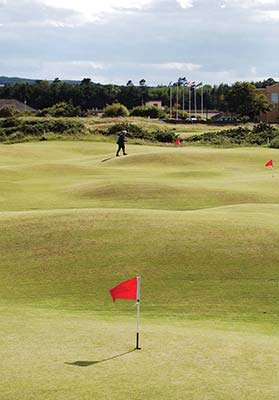
Cost and Hours: £3 for 18 holes. The putting green is open to nonmembers (tourists like you) Mon-Fri 10:30-18:30, Sat until 18:00, Sun from 12:00, weekends-only Oct and March, closed in winter, tel. 01334/475-196, www.standrewsputtingclub.com.
This exhibit, which started as a small collection in the R&A Clubhouse across the street, is the best place in Britain to learn about the Scots’ favorite sport. It’s fascinating for golf lovers.
Cost and Hours: £8, April-Oct Mon-Sat 9:30-17:00, Sun from 10:00; Nov-March daily 10:00-16:00; last entry 45 minutes before closing; café upstairs; Bruce Embankment, in the blocky modern building squatting behind the R&A Clubhouse by the Old Course, tel. 01334/460-046, www.britishgolfmuseum.co.uk.
Visiting the Museum: The compact, one-way exhibit reverently presents a meticulous survey of the game’s history. Start with the film, then follow the counterclockwise route to learn about the evolution of golf—from the monarchs who loved and hated golf (including the king who outlawed it because it was distracting men from church and archery practice), to Tom Morris and Bobby Jones, all the way up to the “Golden Bear” and a randy Tiger. Along the way, you’ll see plenty of old clubs, balls, medals, and trophies, and learn about how the earliest “feathery” balls and wooden clubs were made. Touchscreens invite you to learn more, and you’ll also see a “hall of fame” with items donated by today’s biggest golfers. Finally, you’ll have a chance to dress up in some old-school golfing duds and try out some of that antique equipment for yourself.
Owing partly to the high-roller golf tourists flowing through the town, St. Andrews’ accommodations are quite expensive. During graduation week in June, hotels often require a four-night stay and book up quickly. All of the guesthouses I’ve listed are on the streets called Murray Park and Murray Place, between North Street and The Scores in the old town. If you need to find a room on the fly, look around in this same neighborhood, which has far more options than just the ones I’ve listed below.
$$$ Glenderran Guest House offers five plush rooms (including two true singles) and a few nice breakfast extras (no kids under 12, pay same-day laundry, 9 Murray Park, tel. 01334/477-951, www.glenderran.com, info@glenderran.com, Ray and Maggie).
$$ Hoppity House is a bright and contemporary place, with attention to detail and fun hosts Gordon and Heather, who are helpful and generous with travel tips. There’s a lounge and kitchen for guest use and a storage closet for golf equipment. You may find a stuffed namesake bunny or two hiding out among its four impeccable rooms (cash or PayPal only, fridges in rooms, 4 Murray Park, tel. 01334/461-116, mobile 07701-099-100, www.hoppityhouse.co.uk, enquiries@hoppityhouse.co.uk).
$$ Cameron House has five clean and simple rooms around a beautiful stained-glass atrium (two-night minimum in summer, 11 Murray Park, tel. 01334/472-306, www.cameronhouse-sta.co.uk, info@cameronhouse-sta.co.uk, Donna).
$$ Montague Guest House has richly furnished public spaces—with a cozy, leather-couches lounge/breakfast room—and eight nice rooms (21 Murray Park, tel. 01334/479-287, www.montaguehouse.com, info@montagueguesthouse.com, Raj and Judith).
$$ Lorimer House has six comfortable, tastefully decorated rooms, including one on the ground floor (two-night minimum preferred, no kids under 12, 19 Murray Park, tel. 01334/476-599, www.lorimerhouse.com, info@lorimerhouse.com, Mick and Chris).
$$ Doune Guest House’s seven rooms provide a more impersonal but perfectly comfortable place to stay in St. Andrews (breakfast extra, two-night minimum preferred in summer, 5 Murray Place, tel. 01334/475-195, www.dounehouse.com, info@dounehouse.com).
¢ St. Andrews Tourist Hostel has 44 beds in colorful 5- to 8-bed rooms about a block from the base of Market Street. The high-ceilinged lounge is a comfy place for a break, and the friendly staff is happy to recommend their favorite pubs (kitchen, St. Mary’s Place, tel. 01334/479-911, www.hostelsstandrews.com, info@hostelsstandrews.com).
In the summer (early June-Aug), some of the University of St. Andrews’ student-housing buildings are tidied up and rented out to tourists. I’ve listed the most convenient options below (website for both: www.discoverstandrews.com; pay when reserving). Both of these include breakfast and Wi-Fi. Because true single rooms are rare in St. Andrews’ B&Bs, these dorms are a good option for solo travelers.
$ Agnes Blackadder Hall has double beds and private bathrooms; it’s more comfortable, but also more expensive and less central (North Haugh, tel. 01334/467-000, agnes.blackadder@st-andrews.ac.uk).
$ McIntosh Hall is cheaper and more central, but it only has twin beds and shared bathrooms (Abbotsford Crescent, tel. 01334/467-035, mchall@st-andrews.ac.uk).
(See “St. Andrews” map, here.)
$$$ Forgan’s is tempting and popular, tucked back in a huge space behind Market Street in what feels like a former warehouse. It’s done up country-kitschy, with high ceilings, cool lanterns, and a fun energy. It serves up hearty food and offers a tempting steak selection (daily 12:00-22:00, reservations smart, 110 Market Street, tel. 01334/466-973, www.forgansstandrews.co.uk). On Friday and Saturday nights after 22:30, they have live ceilidh (traditional Scottish) music, and everyone joins in the dancing; consider reserving a booth for a late dinner, then stick around for the show. They also have live acoustic music on Thursday evenings.
$$$ Playfair’s, a restaurant and steakhouse downstairs in the Ardgowan Hotel between the B&B neighborhood and the Old Course, has a cozy/classy interior and outdoor seating at rustic tables set just below the busy street. Their bar next door also serves food (daily 12:00-22:00, off-season weekdays open for dinner only, 2 Playfair Terrace on North Street, tel. 01334/472-970).
$$$ The Doll’s House serves dressed-up Scottish cuisine in a stone-and-wood interior or at tables on the square in front, complete with fur throws on the chairs (daily 10:00-22:00, across from Holy Trinity Church at 3 Church Square, tel. 01334/477-422).
$$$$ The Seafood Ristorante, in a modern glassy building overlooking the beach near the Old Course, is like dining in an aquarium. They serve high-end Italian with a focus on seafood in a formal space with floor-to-ceiling windows providing unhindered views (minimum £20/person food order at dinner, daily 12:00-14:30 & 18:00-21:30, reservations a must on weekends and in summer, The Scores, tel. 01334/479-475, www.theseafoodristorante.com).
$$ Little Italy is a crowded Italian joint with all the clichés—red-and-white checkered tablecloths, replica Roman busts, a bit of freneticism, and even a moped in the wall. But the food is authentically good and the menu is massive. It’s popular—make reservations (daily 12:30-22:30, 2 Logies Lane, tel. 01334/479-299).
$$ Kazoku is a casual and satisfying sushi bar that also serves some hot Japanese dishes (seared scallops on a bed of haggis, anyone?). It’s a family business—the name means “family” in Japanese (daily 12:00-14:30 & 17:00-21:30, 6A Greyfriars Gardens, tel. 01334/477-750).
Fish-and-Chips: $ Cromars is a local favorite for takeaway fish-and-chips (and burgers). At the counter, you can order yours to go, or—in good weather—enjoy it at the sidewalk tables; farther in is a small $$ sit-down restaurant with more choices (both open daily 11:00-22:00, at the corner of Union and Market, tel. 01334/475-555). Tailend also has a $ takeaway counter up front (fish-and-chips) and a $$ restaurant with a bigger selection in the back (daily 11:30-22:00, 130 Market Street, tel. 01334/474-070).
(See “St. Andrews” map, here.)
Pubs: There’s no shortage in this college town. These aren’t “gastropubs,” but they all serve straightforward pub fare (all open long hours daily).
Aikmans, run by Barbara and Malcolm (two graduates from the university who couldn’t bring themselves to leave), features a cozy wood-table ambience, a focus on ales, live music (usually Fri-Sat), and simple soups, sandwiches, and snacks (32 Bell Street, tel. 01334/477-425). The Central, right along Market Street, is a St. Andrews standby, with old lamps and lots of brass (77 Market Street, tel. 01334/478-296). Greyfriars, with forgettable food, is in a classy, modern hotel near the Murray Park B&Bs (129 North Street, tel. 01334/474-906).
Coffee: $ Taste, a little café just across the street from the B&B neighborhood, has the best coffee in town and a laid-back, borderline-funky ambience that feels like a big-city coffeehouse back home. It also serves cakes and light food (daily 7:00-18:00 in summer, open later when students are back, 148 North Street, tel. 01334/477-959).
Whisky: Luvians Bottle Shop—run by three brothers (Luigi, Vincenzo, and Antonio)—is a friendly place to talk, taste, and purchase whisky. Distilleries bottle unique single-cask vintages exclusively for this shop to celebrate the British Open every five years (ask about the 21-year-old Springbank they received in 2015 to commemorate the tournament). With nearly 50 bottles open for tastings, a map of Scotland’s whisky regions, and helpful team members, this is a handy spot to learn about whisky. They also sell fine wines and a wide range of microbrews (Mon-Sat 10:00-22:00, Sun from 12:30, 66 Market Street, tel. 01334/477-752).
(See “St. Andrews” map, here.)
Cheese: I.J. Mellis Cheesemonger, the excellent Edinburgh cheese shop with a delectable array of Scottish, English, and international cheeses, has a St. Andrews branch (Mon-Sat 9:00-19:00, Sun 10:00-17:00, 149 South Street, tel. 01334/471-410).
Pastries: Fisher and Donaldson is beloved for its rich, affordable pastries and chocolates. Listen as the straw-hatted bakers chat with their regular customers, then try their Coffee Tower—like a giant cream puff filled with lightly coffee-flavored cream—or their number-one seller, the fudge doughnut (Mon-Sat 6:00-17:00, closed Sun, just around the corner from the TI at 13 Church Street, tel. 01334/472-201).
Gelato: You’ll see many people walking around licking cones from B. Jannettas, which has been around for more than a century. While waiting in line, ponder what you want from their range of 50-plus gelato flavors (daily 9:00-22:00, 31 South Street, tel. 01334/473-285).
Supermarkets: You can stock up for a picnic at Tesco or Sainsbury’s Local on Market Street.
Trains don’t go into St. Andrews—instead, use the Leuchars station (5 miles from St. Andrews, connected by buses coordinated to meet most trains, 2-4/hour, see “Arrival in St. Andrews” on here).
From Leuchars by Train to: Edinburgh (1-2/hour, 1 hour), Glasgow (2/hour, 2 hours, transfer in Haymarket), Inverness (roughly hourly, 3.5 hours, 1-2 changes). Trains run less frequently on Sundays. Train info: Tel. 0345-748-4950, www.nationalrail.co.uk. To reach Dundee, take bus #99 from St. Andrews bus station near the base of Market Street (every 10 minutes, 30 minutes).
Two starkly different destinations are within a half-hour’s drive of St. Andrews, in opposite directions. To the north is the up-and-coming city of Dundee, with a pair of excellent museums (offering more-interesting-than-they-sound, in-depth exhibits on the local jute industry and Antarctic exploration); just beyond is Glamis Castle, the childhood home of Queen Elizabeth’s late mother, known as the Queen Mother. And to the south is the charming string of seaside villages called the East Neuk. Either one makes a good half-day side-trip, or you can squeeze them in on your way between St. Andrews and other destinations.
The once-prosperous, then decrepit, and now steadily rejuvenating city of Dundee (Scotland’s fourth-largest, with about 150,000 people) sits at the mouth of the River Tay. In its heyday, Dundee was known for the “Three J’s”: jute (turning the raw fiber into rope, burlap, and canvas), jam (importing that orange marmalade that’s on every B&B breakfast table), and journalism (being the home of D. C. Thomson & Co., the respected publishing company responsible for the Sunday Post and for creating many beloved Scottish cartoon characters).
Then, like many Industrial Age British boomtowns, Dundee fell on hard times in the 20th century. Today, thanks to some promising rejuvenation through the tech industry, Dundee is working to reinvent its downtown core and its waterfront (where a huge mess of construction will eventually become a £80-million branch of the Victoria & Albert Museum—due to open in 2018). But the city still has a ways to go, and for now it merits only a quick stop for two interesting museums.
Getting There: Drivers can take advantage of nearby parking for a strategic visit to one or both of Dundee’s museums. The Discovery Point museum along the waterfront is well signed and easy to find. The Verdant Works Jute Museum is buried in a mostly deserted industrial area higher up in town (look for brown signs), but it’s more reliably found by using GPS or an app. Train travelers find that Discovery Point is easy (it’s right across the street from the train station), but the Verdant Works Jute Museum, just under a mile away, isn’t well connected by public transit; walk or take a taxi from Discovery Point.
At the turn of the 20th century—long after the Age of Discovery—Antarctica was the world’s last great mystery. With fervor matched a half-century later in the Space Race, ambitious countries set out to learn more about the unexplored continent. This museum tells the story of the Royal Research Ship (RRS) Discovery, which was built in Dundee and set sail for Antarctica in 1901. It was one of the most successful scientific expeditions of its time. This attraction, on Dundee’s riverfront, has two parts: a museum about the ship and the expeditions that it undertook, and the actual ship, restored to how it was in 1924.
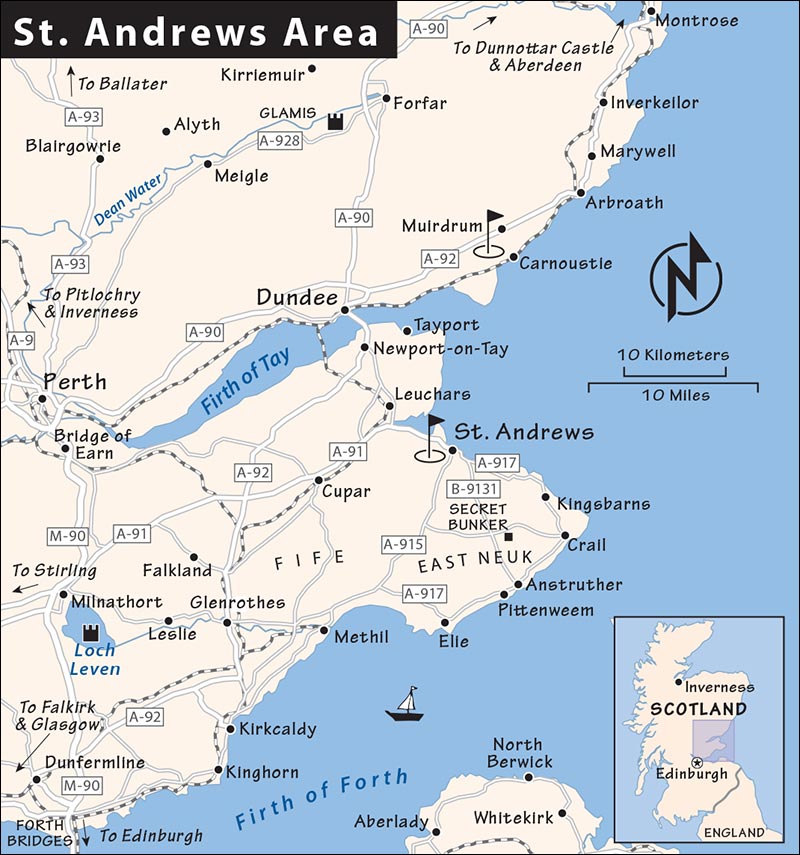
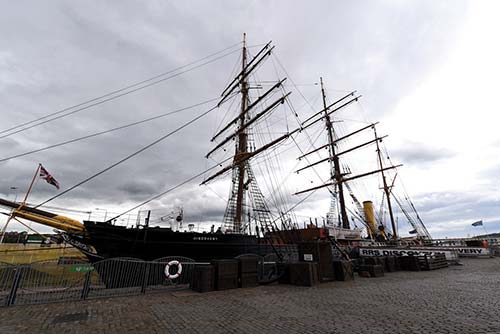
Cost and Hours: £9.25, £16 combo-ticket with Verdant Works Jute Museum; Mon-Sat 10:00-18:00, Sun 11:00-18:00, off-season daily until 17:00, last entry one hour before closing; audioguide-£3, Riverside Drive, closest parking is next door at Discovery Car Park, tel. 01382/309-060, www.rrsdiscovery.com.
Visiting the Museum: Begin by touring the museum (all well-described) to better appreciate the ship and the role it played in navigation history. You’ll learn how the Discovery was built and provisioned, and how the crew (led by Commander Robert Falcon Scott, who died a decade later in a race to the South Pole) planned and perilously executed their icy journey. The exhibit explains that when the ship set sail in 1901, less was known about Antarctica than was known about the moon when the first Apollo mission landed in 1969. A good 10-minute film helps provide historical context.
Head outside to the ship itself (with a few brief informational plaques) to walk across the decks and delve below to see the engine room, galley, sick bay, mess deck, and living quarters. The photographic darkroom, drawing table, and vials for scientific samples illustrate the ship’s mission: opening up a new continent to human understanding.
Hardworking, industrious Scotland has several fine museums about how things are made—and this is one of the best. Filling a former jute-processing factory called Verdant Works, it’s located in a run-down but gentrifying zone of brick factories. This museum explores every facet of the jute industry that put Dundee on the map. Especially worthwhile for those with a healthy interest in engineering, the well-presented museum accomplishes the remarkable task of making jute interesting even to those less mechanically inclined.
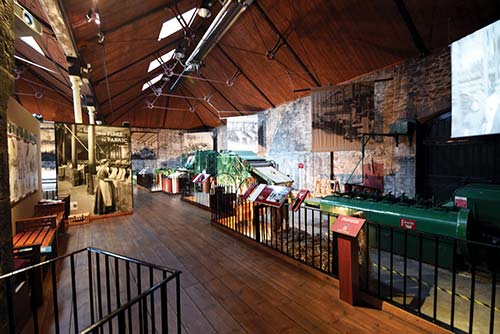
Cost and Hours: £9.25, £16 combo-ticket with Discovery Point, same hours as Discovery Point, West Henderson’s Wynd, free parking lot in back, tel. 01382/309-060, www.verdantworks.com.
Background: Starting in the 1830s, Dundee businessmen—who came to be known as “jute barons”—developed a local industry around processing the fiber of a plant called jute, which could be used to make rope, burlap sacks, sails, canvases, carpeting, and even clothing. In an age before plastics, versatile jute was a prized material...and virtually all of the world’s supply came through Dundee. Great Britain’s nautical expansion further boosted the industry: Dundee-made materials sailed to every corner of the earth. Coinciding with the Highland Clearances and the decline of traditional rural lifestyles, the jute boom lured many floundering farmers and peasants into urban factories. By century’s end, Dundee’s population had tripled.
In Dundee, as in other Industrial Age cities, rapid changes created a sharply stratified society, with a tiny and obscenely wealthy upper class and a huge, desperately poor lower class. But before long, the jute industry fell victim to “outsourcing,” a century before our time: By 1875, a jute factory opened in India (where the raw materials were harvested), and by 1900, more jute products were produced in Calcutta than in Dundee. The rise of plastics and other synthetic fibers in the 1970s drove the final nail into the industry’s coffin; Dundee’s last remaining jute factory closed in 1999.
Visiting the Museum: Try to start your visit with the 15-minute Juteopolis film (which sets the stage for the museum and helps explain why you’re spending your vacation learning about jute) in a theater behind the ticket desk. But if it’s not starting soon, you can keep going with your tour because you’ll come to the theater again later in your visit.
Head across the courtyard to the Works Office and follow the one-way route through the exhibit. The highlight is the machine hall, where you’ll see working (but much smaller) versions of the machinery used for each of the steps required to turn this tropical fiber into practical products. On some days, docents are standing by to explain more and demonstrate some of the century-old equipment.
Upstairs (access from outside, in the courtyard) is an exhibit about the social history of the city, showing different walks of life relating to the jute industry. The cavernous High Mill has more exhibits delving into different facets of the industry and a huge Boulton and Watt steam engine from 1801, still in working order.
With a little time to spare, it’s worth walking 10 minutes from Discovery Point to the town center. In front of the city’s landmark Caird Hall concert venue (with the TI next door), you’ll find a bustling, traffic-free people zone, with cafés, public tables, fountains, and a glitzy shopping mall. Find the life-sized statues of Desperate Dan and Minnie the Minx (Dundee-born cartoon characters who are as beloved among Scots as they are unknown to Americans). A quick walk here offers a peek into the Dundee of the future.
A 20-minute drive north of Dundee (or 45 minutes north of St. Andrews) is the residence of the Earls of Strathmore—best known as the childhood-home castle of the Queen Mother (a.k.a. Elizabeth Bowes-Lyon, 1900-2002). Glamis (pronounced “glahms”) is a proper castle inside and out: You’ll drive down a grand, tree-lined driveway to a majestic palace bristling with turrets and filled with elaborately decorated rooms that drip with history and blue-blood quirk. Coming here just seems the right way to pay respects to the Queen Mother, who gave birth to the longest-reigning monarch in British history and supported her husband, King George VI, as he rallied Britain through World War II (as depicted in The King’s Speech). Their second daughter, Princess Margaret, was born right here at Glamis—the first royal baby born in Scotland in 300 years. The “Queen Mum” always had a deep affection for her home at Glamis and was often clad in a distinctive hue that she liked to call “Strathmore blue.”
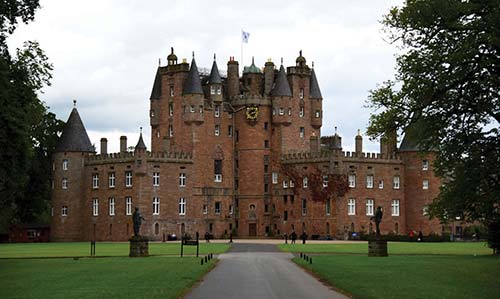
Cost and Hours: £12.50, daily 10:00-16:30 (last tour time), weekends-only Nov-early Dec, closed early Dec-Easter, tel. 01307/840-393, www.glamis-castle.co.uk.
Getting There: From Dundee, head north on the A-90 expressway (toward Aberdeen); the exit is well marked with brown Glamis Castle signs (also marked for Kirriemuir). From the exit, follow the A-928 seven miles to the castle.
Visiting the Castle: You can only visit the interior on a 50-minute guided tour. You’ll see both grand state rooms and intimate quarters—including the private rooms of the Queen Mother, which her parents installed after she married the prince to ensure she’d keep coming home for visits. The tour is packed with fun insights into aristocratic eccentricities, from the paintings of one earl who simply adored his leather body armor (painted to resemble a sculpted Greek god), to a rare painting of Jesus wearing a hat. Glamis also loves to tout its title as the “most haunted castle in Scotland”—though the ghost tales your guide imparts are more silly than scary. (Even more suspect are boasts that Glamis inspired Shakespeare as the setting for Macbeth—a claim also made by Cawdor Castle.) After your tour, you can visit a few more exhibits and explore the grounds on your own—a handout suggests several walking routes.
On the lazy coastline meandering south from St. Andrews, the cute-as-a-pin East Neuk (pronounced “nook”) is a collection of tidy fishing villages. While hardly earth-shattering, the East Neuk is a pleasant detour if you’ve got the time. The villages of Crail and Pittenweem have their fans, but Anstruther is worth most of your attention. The East Neuk works best as a half-day side-trip (by either car or bus) from St. Andrews, though drivers can use it as a scenic detour between Edinburgh and St. Andrews.
Getting There: It’s an easy drive from St. Andrews. For the scenic route, follow the A-917 south of town along the coast, past Crail, on the way to Anstruther and Pittenweem. For a shortcut directly to Anstruther, take the B-9131 across the peninsula (or return that way after driving the longer coastal route there). Buses connect St. Andrews to the East Neuk: Bus #95 goes hourly from St. Andrews to Crail and Anstruther (50 minutes to Anstruther, catch bus at St. Andrews bus station or from Church Street, around the corner from the TI). The hourly #X60 bus goes directly to Anstruther, then on to Edinburgh (25 minutes to Anstruther, 2 hours more to Edinburgh). Bus info: Tel. 0871-200-2233, www.travelinescotland.com.
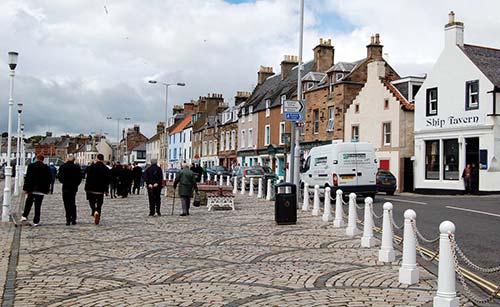
Stretched out along its harbor, colorful Anstruther (AN-stru-ther; pronounced ENT-ster by locals) is the centerpiece of the East Neuk. The main parking lot and bus stop are both right on the harbor. Anstruther’s handy TI, which offers lots of useful information for the entire East Neuk area, is located next door to the town’s main sight, the Scottish Fisheries Museum (open daily in summer, closed Nov-March, tel. 01333/311-073). Stroll the harborfront to the end, detouring inland around the little cove (or crossing the causeway at low tide) to reach some colorful old houses, including one encrusted with seashells.
Anstruther’s Scottish Fisheries Museum is true to its slogan: “We are bigger than you think!” The endearingly hokey exhibit sprawls through several harborfront buildings, painstakingly tracing the history of Scottish seafaring from primitive dugout dinghies to modern vessels. You’ll learn the story of Scotland’s “Zulu” fishing boats and walk through vast boat-filled rooms. For a glimpse at humble fishing lifestyles, don’t miss the Fisherman’s Cottage, hiding upstairs from the courtyard (open daily, tearoom, Harbourhead, tel. 01333/310-628, www.scotfishmuseum.org).
Eating in Anstruther: Anstruther’s claim to fame is its fish-and-chips. Though there are several good chippies in town, the famous one is the Anstruther Fish Bar, facing the harbor just a block from the TI and Fisheries Museum (take out or dine in for a few pounds more, open long hours daily, 42 Shore Street, tel. 01333/310-518).
Among the rolling farm fields between St. Andrews and the East Neuk, a blink-and-you’ll-miss-it stone farmhouse conceals a sprawling network of corridors: 24,000 square feet, 100 feet under the ground, protected by 10-foot-thick reinforced concrete walls. You’ll climb down the stairs and hike through a long tunnel to explore a warren of Cold War-era control rooms, dormitories, and telecommunications centers, plus a chapel and the office of the Minister of State of Scotland (who would command the military in the event of an attack). Black-and-white films calmly explain to homeowners how to prepare for—and cope with—a nuclear attack.
The exhibit itself is overpriced and frustratingly hokey—a jumble of 1970s technology, scarcely explained other than by the melodramatic audioguide. But for those interested in the Cold War, simply exploring this space can be a powerful experience.
The most striking part of the experience is watching the 46-minute BBC-produced film The War Game, a harrowing dramatization of what would happen in the event of a nuclear attack. Its “Keep Calm and Carry On,” pull-no-punches straightforwardness is a haunting reminder of an age when global nuclear holocaust seemed not only possible, but likely. (Produced in 1965, the film was immediately branded too disturbing to broadcast, and was not shown on the BBC for 20 years.)
Cost and Hours: £12, daily 10:00-18:00, closed Nov-Feb, last entry one hour before closing, audioguide-£2, tel. 01333/310-301, www.secretbunker.co.uk.
Getting There: Head out of St. Andrews toward Crail, but just outside of town, turn off on the right toward Dunino and Anstruther (on the B-9131). Then follow brown Secret Bunker signs about six miles through farmland.